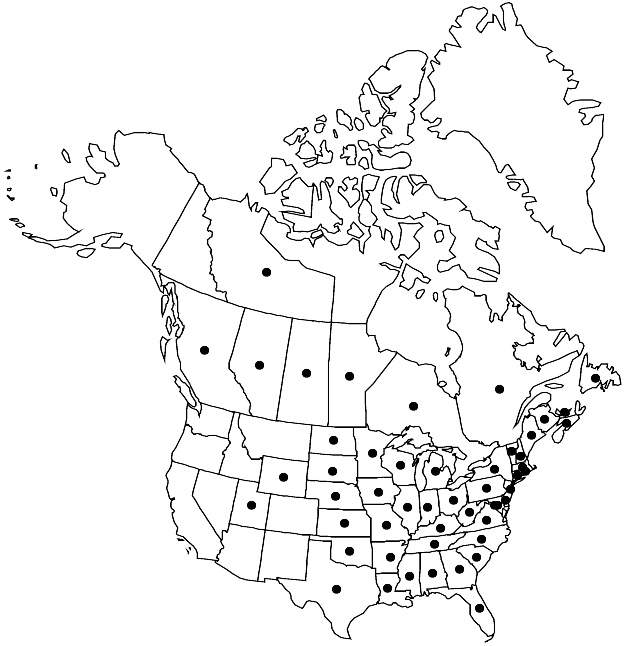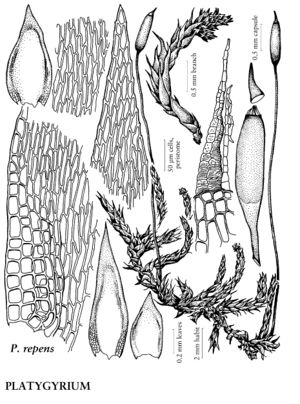Platygyrium repens
in P. Bruch and W. P. Schimper, Bryol. Europ. 5: 98. 1851.
Plants small to moderately large, green to bronze or darker, often blackish. Stems with branches short or sometimes elongate, ascending, loosely foliate or sometimes julaceous, curved at apices or sometimes straight. Leaves ascending to imbricate, not plicate, 0.8–1.1 mm; margins inconspicuously to strongly recurved proximally; apex acute to acuminate; medial laminal cells 44–57 × 5–6 µm. Specialized asexual reproduction by brood branchlets, many and conspicuous on branch apices. Seta 1.2–2 cm. Capsule subcylindric, symmetric or slightly asymmetric, 1–2.5 mm; operculum slenderly long-rostrate. Calyptra 1.5–2 mm. Spores 13–18 µm.
Phenology: Capsules mature Aug–Apr, Jun.
Habitat: Shady, moist forests, logs, stumps, tree trunks and bases, old wood structures, shaded rock, soil
Elevation: low to high elevations (0-2000 m)
Distribution

Alta., B.C., Man., N.B., Nfld. and Labr. (Nfld.), N.W.T., N.S., Ont., P.E.I., Que., Sask., Ala., Ark., Conn., Del., D.C., Fla., Ga., Ill., Ind., Iowa, Kans., Ky., La., Maine, Md., Mass., Mich., Minn., Miss., Mo., Nebr., N.H., N.J., N.Y., N.C., N.Dak., Ohio, Okla., Pa., R.I., S.C., S.Dak., Tenn., Tex., Utah, Vt., Va., W.Va., Wis., Wyo., Europe, Asia, Africa.
Discussion
Platygyrium repens is one of the most ubiquitous pleurocarpous mosses in eastern North America. The species fruits infrequently in the northern reaches of its range and not at all in the southern portions. Brood branches are usually present and are rarely elongate and in such abundance that the plants dissolve into seemingly amorphous masses of slender branchlets. Although most specimens of P. repens can be identified easily, occasional sterile specimens lacking brood branchlets may defy certain identification. Homomallium adnatum sometimes has brood branchlets at its branch apices, and some sterile specimens may not be confidently distinguished from sterile specimens of P. repens. However, in H. adnatum the medial laminal cells are generally much shorter (rhombic or to 3–5:1) than those of P. repens, and foliose paraphyllia are sometimes present in the former but absent in P. repens. Erect branches bearing brood branchlets at their apices are also common in Leskeella nervosa, a more slender, dull, brownish, plant with narrow costate leaves, which co-occurs with P. repens in the northern reaches of its range.
Selected References
None.
